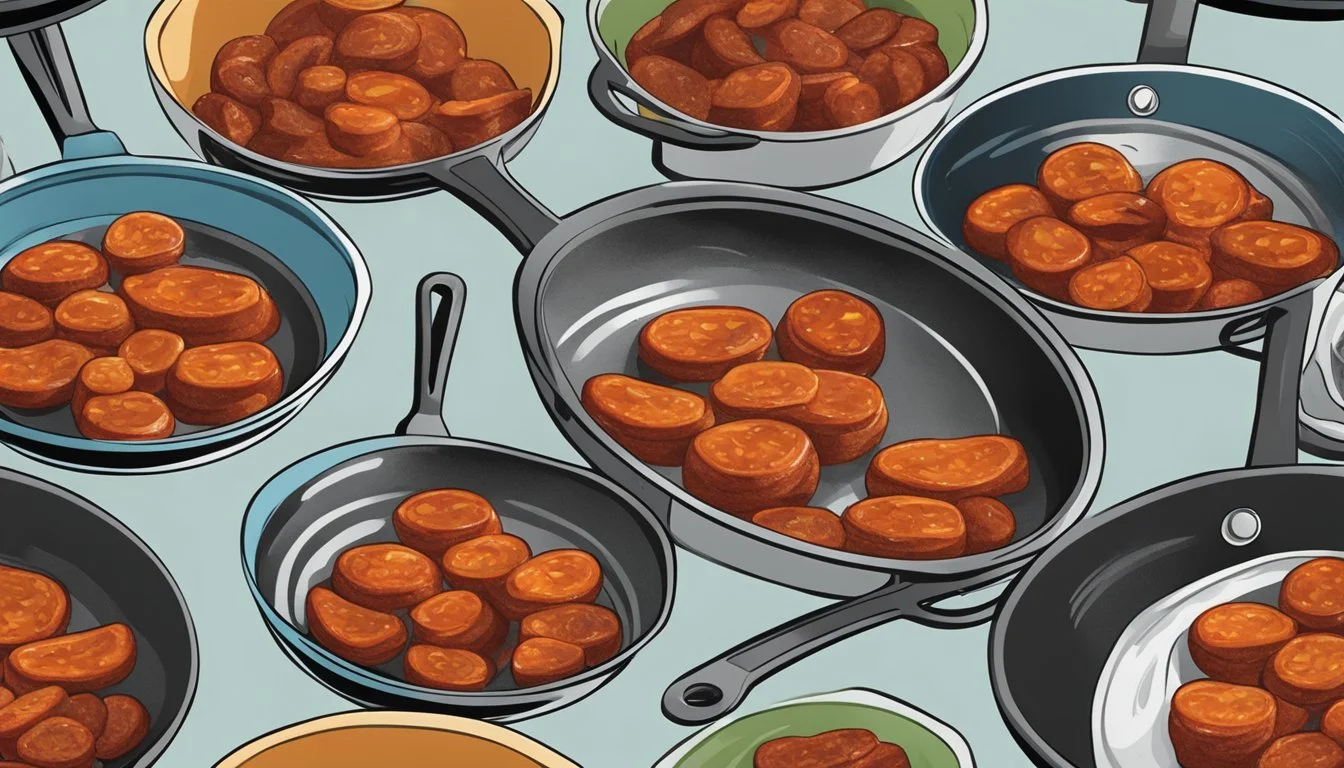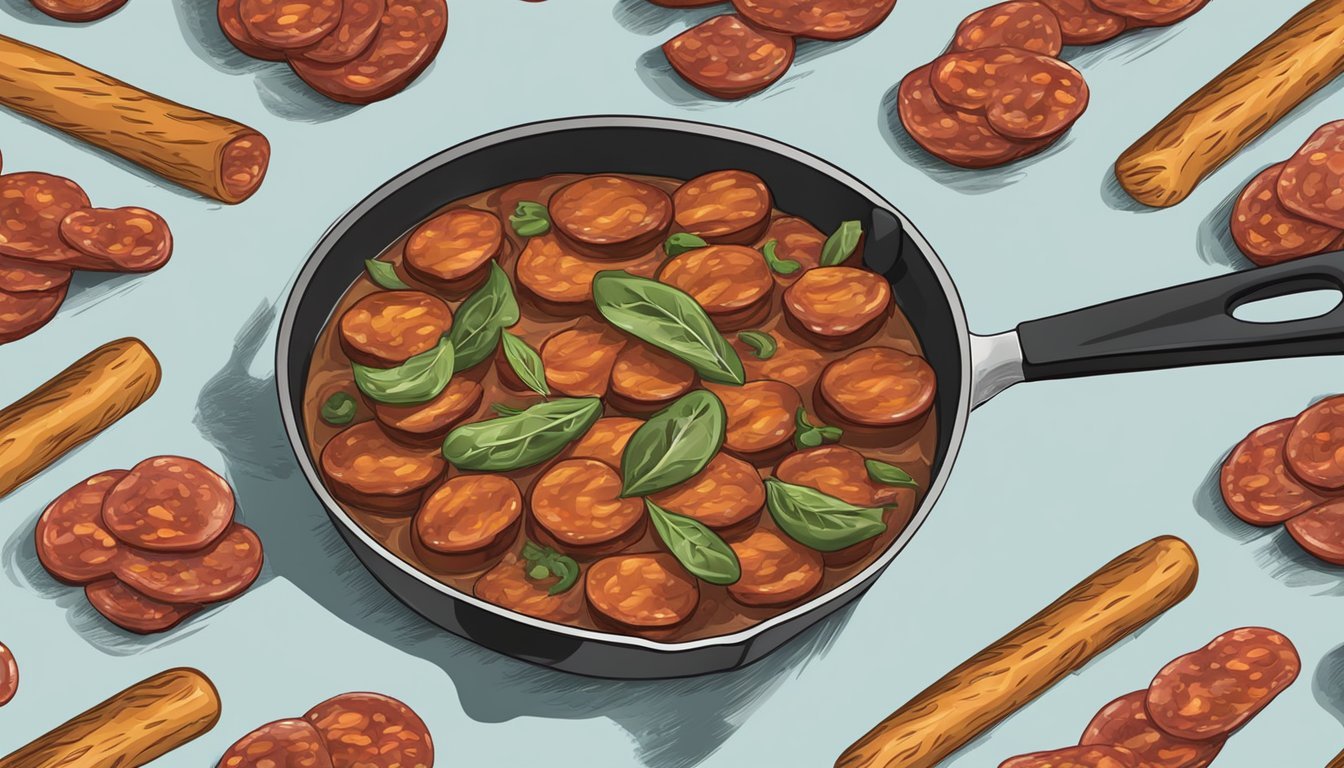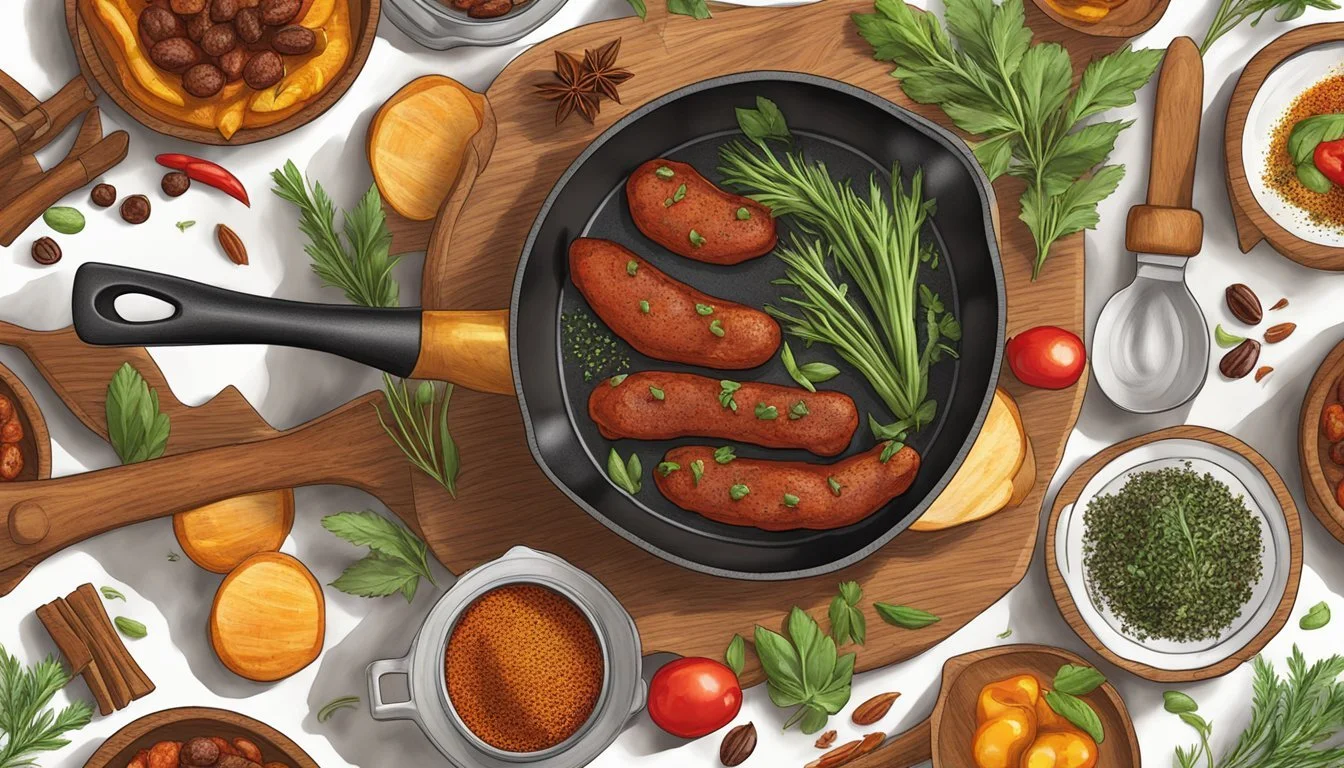How to Reheat Chorizo for Perfect Flavor and Texture
Reheating chorizo is an art that requires a balance between preserving its rich flavor and ensuring food safety. Chorizo, whether sliced or in whole links, can be reheated effectively using several methods. The key is to reach an internal temperature of 165 degrees Fahrenheit (74 degrees Celsius), guaranteeing that all harmful bacteria are eliminated, while also maintaining its savory goodness.
For those who prioritize texture and quality, using an oven or stovetop can yield the best results. Spreading chorizo slices on a baking sheet and baking at 350°F (175°C) for about 10-15 minutes can help retain its crispiness. Similarly, sautéing it in a pan over low heat can rejuvenate its flavor and texture without drying it out.
For quicker methods, microwaving and air frying are viable alternatives. In a microwave, chorizo should be heated in 30-second increments, stirring regularly to ensure even heating. Utilizing an air fryer at 350°F (175°C) for 3 to 4 minutes can also result in a thoroughly reheated, delicious chorizo. No matter the method chosen, the ultimate goal remains to enjoy chorizo that is both safe and delectable.
Understanding Chorizo
Chorizo, a highly seasoned sausage, varies greatly depending on its origin. It can be made from pork or beef and is known for its robust flavors, which typically come from paprika, garlic, and other spices.
Types of Chorizo
There are two primary types of chorizo: Mexican chorizo and Spanish chorizo. Mexican chorizo is usually made with fresh, raw pork or beef and is often sold in a loose, ground form or in casings. It is typically cooked before consumption and has a softer texture.
Spanish chorizo, on the other hand, is a cured and fermented sausage made from pork. It is seasoned heavily with garlic and smoked paprika, which gives it a rich, smoky flavor. This type of chorizo is usually firm and can be eaten without further cooking, making it more suitable for reheating.
Flavor Profile and Texture
Mexican chorizo brings a spicy, tangy flavor and a soft, crumbly texture due to its higher fat content and raw preparation process. The flavors are bold, with an emphasis on vinegar, chili peppers, and spices.
Spanish chorizo offers a smoky, rich flavor profile, thanks to the paprika. Its texture is usually firm and chewy, owing to the curing process. The garlic and spices blend harmoniously, delivering a complex taste that is both savory and slightly spicy.
Proper Storage Techniques
Correctly storing chorizo is essential to maintain its flavor and safety. Fresh Mexican chorizo should be refrigerated and used within a few days or frozen for up to two months. When freezing, wrap it tightly to prevent freezer burn.
For Spanish chorizo, which is cured, it can be stored at room temperature in a cool, dry place if it is whole. Once sliced, it should be refrigerated and consumed within one to two weeks to maintain its quality. Always store it in an airtight container to preserve its distinctive flavors.
Pre-Reheating Guidelines
Before reheating leftover chorizo, ensure proper storage to maintain quality and safety.
Store chorizo in an airtight container. Keep it in the refrigerator at 40°F (4°C) or below. This prevents bacterial growth.
Refrigeration Guidelines
Refrigerate leftover chorizo within two hours of cooking.
Consume refrigerated chorizo within three to four days.
For storage beyond four days, freezing is recommended.
Freezing Guidelines
Place chorizo in a freezer-safe container or wrap it tightly in aluminum foil or plastic wrap.
Label containers with the date.
Freeze at 0°F (-18°C) or below.
Use frozen chorizo within two to three months for the best quality.
Room Temperature
Avoid leaving chorizo at room temperature for extended periods. Bacteria multiply rapidly between 40°F and 140°F (4°C and 60°C).
Food Safety and Considerations
When reheating, ensure the chorizo reaches an internal temperature of 165°F (74°C). Use a food thermometer to verify. Microwave reheating requires stirring and covering the chorizo and allowing it to stand for two minutes after heating.
These simple steps help ensure your chorizo remains safe and flavorful before reheating.
Reheating Chorizo on the Stovetop
Stovetop reheating is a great way to warm up chorizo, whether fresh or pre-cooked.
Preparation:
Choose a non-stick skillet or regular skillet for even heating.
Add a small amount of olive oil if using a regular skillet to prevent sticking.
Procedure:
Preheat the skillet over medium heat.
Place the chorizo pieces in the skillet.
Cook, stirring occasionally, until the chorizo is heated through.
Monitor the internal temperature with an instant-read thermometer. The chorizo should reach 160°F (71°C).
Tips to Avoid Overcooking:
Keep an eye on the chorizo to prevent it from becoming too dry.
Adjust heat if necessary to maintain a gentle simmer.
By following these steps, you can successfully reheat chorizo on the stovetop without compromising its flavor or texture.
Reheating Chorizo in the Oven
Reheating chorizo in the oven is a straightforward method that ensures even heating and a slightly crispy exterior.
First, preheat the oven to 350°F (175°C). This temperature is ideal for warming the chorizo without drying it out.
Spread a piece of parchment paper on a baking sheet. This prevents sticking and makes cleanup easier.
Lay the chorizo slices in a single layer on the baking sheet. Make sure they are not overlapping to ensure even reheating.
Place the baking sheet in the preheated oven. Bake for 10 to 15 minutes. The chorizo should be heated through and may develop a slight crispiness on the edges.
Using a kitchen thermometer, check that the internal temperature of the chorizo reaches at least 160°F (71°C). This ensures it is thoroughly reheated.
Tip: Sprinkle a pinch of kosher salt over the chorizo before reheating for an extra burst of flavor.
For leftovers, this oven method is excellent as it brings the chorizo back to life without making it dry or rubbery.
Remember to monitor the chorizo closely towards the end of the reheating process to prevent overcooking.
Reheating Chorizo Using a Microwave
Reheating chorizo in a microwave is quick and efficient. This method is particularly useful for those short on time.
To begin, place the chorizo in a microwave-safe bowl or dish. Cover the container with a microwave-safe lid or a piece of microwave-safe plastic wrap to retain moisture.
Microwave the chorizo on high for 1-2 minutes. It's crucial to stir the chorizo halfway through the reheating process to ensure even heating.
Check the temperature using an instant-read thermometer. The chorizo should reach an internal temperature of 160°F (71°C) to ensure it is safe to eat.
Pay attention to the texture and moisture. Microwaves can sometimes dry out food, so covering the chorizo helps retain its juiciness. If the chorizo seems dry, add a small amount of water or broth before reheating.
Safety considerations are paramount. Always reheat in short bursts and check frequently to avoid overcooking. Overcooked chorizo may become tough and less flavorful.
For best results, avoid overfilling the container to ensure even reheating. It is better to reheat in smaller batches if necessary.
By following these straightforward steps, one can effectively reheat chorizo while preserving its delicious flavor and texture.
Alternative Reheating Methods
Air Fryer
The air fryer provides a quick and efficient way to reheat chorizo. Preheat the air fryer to around 350°F (175°C). Place the chorizo in a single layer in the basket and heat for 3 to 4 minutes. Use an instant-read thermometer to check if the internal temperature has reached 160°F (71°C).
Toaster Oven
A toaster oven is another effective method for reheating chorizo. Preheat the oven to 350°F (175°C). Place the chorizo on a baking sheet and heat for 10-15 minutes. Ensure the internal temperature reaches 165°F (74°C) for proper reheating.
Slow Cooker
For a hands-off approach, the slow cooker can gently reheat chorizo. Set the slow cooker to a low setting and place the chorizo inside. Cover and heat for 1-2 hours. This method helps retain the chorizo’s moisture and enhances its flavor.
Stove Top
Reheating on the stovetop is an excellent technique for maintaining flavor and texture. Add a small amount of oil to a pan and set it to medium heat. Cook the chorizo for about 5-7 minutes, stirring occasionally. This method works well for incorporating chorizo into dishes like tacos.
Creative Ways
For those seeking creative ways to reheat chorizo, consider grilling or sautéing. Grilling lends a smoky flavor, while sautéing in a hot pan can create a crispy exterior. Both methods can elevate the overall quality of the reheated chorizo, enhancing its taste and texture.
Maintenance of Quality
Each method offers unique benefits for reheating chorizo, ensuring the preservation of its distinct flavor and texture. By selecting the right technique, one can enjoy delicious, evenly reheated chorizo without compromising on quality.
Serving Reheated Chorizo
Reheated chorizo retains its flavor and texture, making it a versatile addition to several meals. Here are some ideas for serving:
Chorizo Tacos
Use corn tortillas or flour tortillas.
Add reheated chorizo as the main filling.
Garnish with onions, fresh cilantro, and lime juice.
Top with avocado and a dollop of sour cream.
Sprinkle with queso fresco for extra flavor.
Chorizo Burritos
Warm flour tortillas.
Fill with reheated chorizo.
Add beans, rice, avocado, and sour cream.
Roll and serve with a side of lime wedges for an extra kick.
Breakfast Options
Combine reheated chorizo with scrambled eggs.
Serve with warm corn tortillas.
Add fresh cilantro and a squeeze of lime juice.
Serving Tips
Always ensure the chorizo is properly reheated to 165°F (74°C) to maintain safety.
Pair with fresh avocado slices and a side of sour cream for creamy textures.
Use lime wedges for a fresh, zesty finish.
Meal Ideas
Chorizo is suitable for any meal of the day:
Breakfast: Chorizo and egg tacos.
Lunch: Chorizo burritos.
Dinner: Chorizo tacos with all the fixings.
These suggestions help you get the most out of reheated chorizo, ensuring it remains flavorful and delicious.
Safety Considerations When Reheating Chorizo
When reheating chorizo, it is crucial to ensure it reaches a safe internal temperature. Utilize a meat thermometer to verify that the chorizo hits at least 165°F (74°C). This temperature is essential to make sure the meat is safe to eat and free from harmful bacteria.
Foodborne illness can be a concern if chorizo is not reheated properly. To prevent this, always store leftover chorizo promptly in the refrigerator and consume it within a safe timeframe. Reheat only the portion you intend to eat to avoid repeated heating, which can reduce quality and safety.
For even heating, consider breaking the chorizo into smaller pieces. This ensures that all parts of the meat are heated evenly and reach the necessary temperature, reducing the risk of foodborne illness.
Cover the chorizo with foil or add a splash of water when reheating in the oven or pan for moisture retention. This step can help maintain the meat’s juiciness while still reaching a safe internal temperature.
Follow these guidelines strictly to ensure that reheated chorizo is not only delicious but also safe to eat.
Maximizing the Quality of Reheated Chorizo
Reheating chorizo can be straightforward if specific guidelines are followed to maintain its quality.
Fresh Chorizo
Fresh chorizo should be refrigerated promptly. When ready to reheat, preheat the air fryer to 350°F (175°C). Place the chorizo in the basket in a single layer and heat for 3-4 minutes, ensuring it reaches an internal temperature of 160°F (71°C).
Frozen Chorizo
Ensure frozen chorizo is thawed properly in the refrigerator. Once thawed, preheat the oven to 350°F (175°C). Arrange the chorizo on a baking sheet lined with parchment paper. Reheat for 10-15 minutes until it reaches an internal temperature of 165°F (74°C).
Loss of Flavor
Minimize flavor loss by reheating chorizo gently. Rapid temperature changes can degrade its taste and texture. Use lower heat settings and a short duration to help preserve its savory qualities.
Storage Tips
Store chorizo in airtight containers or wrap it tightly in plastic wrap before placing it in the refrigerator or freezer. This helps retain moisture and prevents freezer burn, which can compromise quality.
Reheating Methods
Air Fryer: Ideal for retaining crispness. Preheat to 350°F (175°C) and heat for 3-4 minutes.
Oven: Ensures even heating. Preheat to 350°F (175°C) and bake for 10-15 minutes.
Stovetop: Suitable for small portions. Heat in a pan over medium heat until warmed through.
By following these guidelines, reheated chorizo can maintain its flavor and texture, making it just as enjoyable as when it was freshly cooked.
Incorporating Reheated Chorizo into Recipes
Reheated chorizo can be a culinary delight, adding depth and flavor to various dishes. Its versatility makes it suitable for a variety of recipes, from scrambled eggs to hearty soups and stews.
Chorizo Scrambled Eggs: Mix reheated ground chorizo with scrambled eggs for a spicy kick. Add freshly ground black pepper and jalapeños for extra heat. Serve with flour wraps for a delicious breakfast burrito.
Chorizo Hash: Combine reheated chorizo with potatoes, onions, and roasted corn. Cook in a skillet until everything is crispy and well-mixed. For added flavor, top with lime crema.
Chorizo Pizza: Spread pizza dough with tomato sauce, then add reheated chorizo, fresh ingredients like chicken or beef, and freshly ground black pepper. Bake until the crust is golden and the toppings are sizzling.
Chorizo Soup or Stew: Reheated chorizo can enhance any soup or stew. Combine it with beans, vegetables, and broth to create a robust chorizo soup. This works well with beans, potatoes, and fresh herbs.
Pasta: Add reheated chorizo to your favorite pasta dish. It pairs well with tomato-based sauces or creamy alfredo sauce. Mix in freshly ground black pepper and top with grated cheese for a rich meal.
Reheated chorizo is not just a way to prevent waste but also a gateway to creating mouth-watering dishes. From simple breakfast wraps to complex pasta and stew recipes, its rich, spicy flavor can elevate any meal into a culinary treasure.







